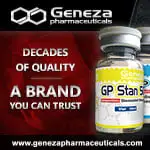Age: 40ish
Current Weight: 202 lbs (as of April 15)
Last Cut: 182 lbs (Feb 10)
---
Cycle Overview:
Anavar: 30–50mg/day
Turinabol (Tbol): 20–70mg/day
Proviron: 50mg/day split across 3–4 doses
Dosing Strategy: Based on planned weekly output — deload vs. max output
---
Grocery List / Macronutrient Sources:
Carbohydrates:
Honey
Dextrose
Skim Milk
Berries
Bananas
Oats
Basmati Rice
Yellow Potatoes
Sweet Potatoes
Mixed Frozen Vegetables
Protein:
Eggs
Costco Chicken Breast
Trimmed Pork Loin (Roasted)
Quattro Protein Powder
Whey Protein
Fats:
2% Milk
Feta Cheese
Avocado Oil
Sesame Oil
---
Macronutrient Goals (per training demand):
Deload Weeks:
Carbs: 450–500g
Protein: 250–275g
Fats: ~100g
Max Output Weeks:
Carbs: 750–950g
Protein: 260–300g
Fats: 75–95g (lower fat on high-carb days)
Tracked via Lifesum App
---
Supplement Stack (BOX System):
BOX 1 — 7:00 AM
Proviron (AM dose)
D-Amphetamine 20mg (10mg on Halo days)
Cardarine 15mg
Sea Salt 2g
Electrolyte Blend
Potassium Citrate
Pomegranate Extract
L-Tyrosine 1000mg
Anavar (AM dose)
Turinabol (AM dose)
L-Carnitine 1.5g
BOX 2 — 10:00 AM
TUDCA 500mg
NAC 600mg
D-Amphetamine 20mg
Curcumin-Pro 500mg
Omega-3 2400mg
Red Yeast Rice 600mg
CoQ10 100mg
Berberine 500mg
Glucosamine/Chondroitin/MSM — 2 tablets
BOX 3 — 1:30 PM
Focus Factor
Vitamin D3 2500 IU
Vitamin K2 100mcg
Moringa 500–1000mg
L-Tyrosine 500mg
Potassium Citrate
Electrolyte Blend
Berberine 250mg
Apple Cider Vinegar 1 tbsp
Boron 3–6mg
BOX 4 — 3:30 PM
Moringa 500–1000mg
Proviron (Midday Dose)
Anavar (PM dose)
Turinabol (PM dose)
L-Carnitine 750mg
BOX 5 — 5:30 PM
TUDCA 500mg
NAC 600mg
Niacinamide 500mg (E2D)
Niacin 500mg (E2D)
Garlic Extract 600mg
Omega-3 1200mg
Curcumin-Pro 500mg
Red Yeast Rice 600mg
CoQ10 100mg
Berberine 250mg
Potassium Citrate
Proviron (PM Dose)
L-Carnitine 750mg
BOX 6 — 9:30 PM
Collagen 10g
Vitamin C 250mg
Magnesium Glycinate 400mg
L-Theanine 100–200mg
GABA 500–750mg
Probiotic
Glucosamine/Chondroitin/MSM — 1 tablet
Ashwagandha 500mg
Proviron
Other:
Taurine: 4g/day
Sodium: 5g from food + 12g Himalayan Salt
Electrolyte Blend:
Custom 3:1:1 (Potassium Citrate : Magnesium Orotate : Taurine) + Salt
---
Pre-Workout Custom Mix:
Citrulline Malate 9g
Beta Alanine 3g
Agmatine Sulfate 1.5g
Niacin 50mg
Pomegranate Powder 1g
Creatine 5g
400ml Coconut Water
(Planned Addition: Betaine Anhydrous 2.5g)
---
Background & History:
Former stucco/stone mason & renovation contractor
Historically fluctuated between 230–250 lbs, peaked just under 300 due to back injury
Malformed L5 vertebrae; stiffness is constant but improving
Transitioned from cut at 210 lbs (25% BF) to 182 lbs (Feb 11) over ~7 months
---
Training Focus:
Torque-Based Movement
Core Bracing
CNS Optimization
---
Daily Delt & Core Stabilization Protocol (15–20 min each)
Delt Movements (Choose 3–4/day):
Lean-Away Lateral Raises – 4x10–15
Rear Delt Flys – 3x15–20
Y-Raises – 3x12–15
Upright Rows – 3x10
Overhead Plate Raises / Bus Drivers – 2x20
20-20-20 Finisher – Lateral / Front / Rear Flys, no rest
Core Movements (Choose 3/day):
Trident Braces (Center + Diagonals = 125–150 total reps)
Weighted Plank Variations – 3x40–60 sec
Pallof Press – 3x15/side
Single-Arm Carries – 3x30 sec/side
Hanging Leg Raise or Ab Wheel – 3x10–15
Rotational Core (Landmine/Cable Chop) – 3x12/side
Sling Line Oblique Lock
Execution Notes:
Run after primary lift or as finisher
Rotate movements biweekly
Focus on control and contraction
Rest ~30s between sets, maintain high pace
---
Main Lifts Focus:
Deadlift / Pulling
Pressing / Pushing
Event Work: Truck Pulls, Sandbags, Medleys
Ill get some pictures up from cut till now and start adding my notes from Halo micro dosing for CNS overloading, Fluffy Bunny Carb Loop and some sample workouts that I have logged.
Current Weight: 202 lbs (as of April 15)
Last Cut: 182 lbs (Feb 10)
---
Cycle Overview:
Anavar: 30–50mg/day
Turinabol (Tbol): 20–70mg/day
Proviron: 50mg/day split across 3–4 doses
Dosing Strategy: Based on planned weekly output — deload vs. max output
---
Grocery List / Macronutrient Sources:
Carbohydrates:
Honey
Dextrose
Skim Milk
Berries
Bananas
Oats
Basmati Rice
Yellow Potatoes
Sweet Potatoes
Mixed Frozen Vegetables
Protein:
Eggs
Costco Chicken Breast
Trimmed Pork Loin (Roasted)
Quattro Protein Powder
Whey Protein
Fats:
2% Milk
Feta Cheese
Avocado Oil
Sesame Oil
---
Macronutrient Goals (per training demand):
Deload Weeks:
Carbs: 450–500g
Protein: 250–275g
Fats: ~100g
Max Output Weeks:
Carbs: 750–950g
Protein: 260–300g
Fats: 75–95g (lower fat on high-carb days)
Tracked via Lifesum App
---
Supplement Stack (BOX System):
BOX 1 — 7:00 AM
Proviron (AM dose)
D-Amphetamine 20mg (10mg on Halo days)
Cardarine 15mg
Sea Salt 2g
Electrolyte Blend
Potassium Citrate
Pomegranate Extract
L-Tyrosine 1000mg
Anavar (AM dose)
Turinabol (AM dose)
L-Carnitine 1.5g
BOX 2 — 10:00 AM
TUDCA 500mg
NAC 600mg
D-Amphetamine 20mg
Curcumin-Pro 500mg
Omega-3 2400mg
Red Yeast Rice 600mg
CoQ10 100mg
Berberine 500mg
Glucosamine/Chondroitin/MSM — 2 tablets
BOX 3 — 1:30 PM
Focus Factor
Vitamin D3 2500 IU
Vitamin K2 100mcg
Moringa 500–1000mg
L-Tyrosine 500mg
Potassium Citrate
Electrolyte Blend
Berberine 250mg
Apple Cider Vinegar 1 tbsp
Boron 3–6mg
BOX 4 — 3:30 PM
Moringa 500–1000mg
Proviron (Midday Dose)
Anavar (PM dose)
Turinabol (PM dose)
L-Carnitine 750mg
BOX 5 — 5:30 PM
TUDCA 500mg
NAC 600mg
Niacinamide 500mg (E2D)
Niacin 500mg (E2D)
Garlic Extract 600mg
Omega-3 1200mg
Curcumin-Pro 500mg
Red Yeast Rice 600mg
CoQ10 100mg
Berberine 250mg
Potassium Citrate
Proviron (PM Dose)
L-Carnitine 750mg
BOX 6 — 9:30 PM
Collagen 10g
Vitamin C 250mg
Magnesium Glycinate 400mg
L-Theanine 100–200mg
GABA 500–750mg
Probiotic
Glucosamine/Chondroitin/MSM — 1 tablet
Ashwagandha 500mg
Proviron
Other:
Taurine: 4g/day
Sodium: 5g from food + 12g Himalayan Salt
Electrolyte Blend:
Custom 3:1:1 (Potassium Citrate : Magnesium Orotate : Taurine) + Salt
---
Pre-Workout Custom Mix:
Citrulline Malate 9g
Beta Alanine 3g
Agmatine Sulfate 1.5g
Niacin 50mg
Pomegranate Powder 1g
Creatine 5g
400ml Coconut Water
(Planned Addition: Betaine Anhydrous 2.5g)
---
Background & History:
Former stucco/stone mason & renovation contractor
Historically fluctuated between 230–250 lbs, peaked just under 300 due to back injury
Malformed L5 vertebrae; stiffness is constant but improving
Transitioned from cut at 210 lbs (25% BF) to 182 lbs (Feb 11) over ~7 months
---
Training Focus:
Torque-Based Movement
Core Bracing
CNS Optimization
---
Daily Delt & Core Stabilization Protocol (15–20 min each)
Delt Movements (Choose 3–4/day):
Lean-Away Lateral Raises – 4x10–15
Rear Delt Flys – 3x15–20
Y-Raises – 3x12–15
Upright Rows – 3x10
Overhead Plate Raises / Bus Drivers – 2x20
20-20-20 Finisher – Lateral / Front / Rear Flys, no rest
Core Movements (Choose 3/day):
Trident Braces (Center + Diagonals = 125–150 total reps)
Weighted Plank Variations – 3x40–60 sec
Pallof Press – 3x15/side
Single-Arm Carries – 3x30 sec/side
Hanging Leg Raise or Ab Wheel – 3x10–15
Rotational Core (Landmine/Cable Chop) – 3x12/side
Sling Line Oblique Lock
Execution Notes:
Run after primary lift or as finisher
Rotate movements biweekly
Focus on control and contraction
Rest ~30s between sets, maintain high pace
---
Main Lifts Focus:
Deadlift / Pulling
Pressing / Pushing
Event Work: Truck Pulls, Sandbags, Medleys
Ill get some pictures up from cut till now and start adding my notes from Halo micro dosing for CNS overloading, Fluffy Bunny Carb Loop and some sample workouts that I have logged.


 Please Scroll Down to See Forums Below
Please Scroll Down to See Forums Below 












































